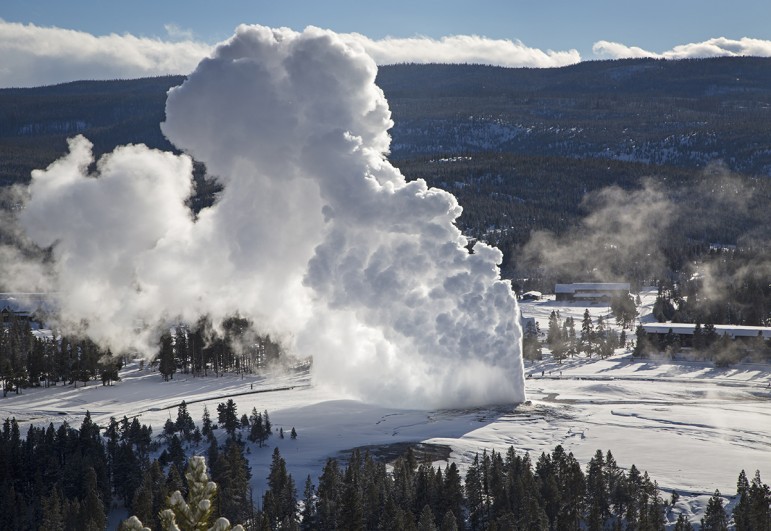
Rising steam from Old Faithful hangs in the frigid air as seen from Observation Point in Yellowstone National Park during a February 2014 cold snap.
Old Faithful is the most popular destination in Yellowstone National Park, but it’s also one of the park’s most fragile natural wonders, and one still not fully understood by researchers and managers charged with protecting the iconic geyser and other nearby thermal features.
A newly released report written by a panel of scientists advises caution in how the Old Faithful area is developed and managed, and recommends additional research meant to better grasp the complex forces driving the Upper Geyser Basin hydrothermal system.
The report recommends consideration of a range of options, including using staging areas and shuttle buses to move some visitors around Old Faithful, removing infrastructure located on hot spots and restricting any new development in certain areas.
The report was issued by the Old Faithful Science Review Panel, made up of experts from the National Park Service, U.S. Geological Survey, academia and the private sector. It will guide management decisions about future development and resource protection around Old Faithful.
The panel met for three days at Old Faithful in June to discuss the history of development around Old Faithful, the latest data on how the complex underground network of thermal features operates and how to best preserve the park’s geysers, hot springs and other wonders while still allowing reasonable public access.
It was clear from those discussions that the leading experts were still looking for better data on how the Upper Geyser Basin’s natural underground plumbing operates.
“It’s about as complex a hydrothermal system as you could expect to find,” said Payton Gardner in June. Gardner is a geologist with Sandia National Laboratories who is studying how the park’s thermal features are recharged by groundwater.
The panel’s report recommends following a “precautionary principle,” which dictates using only proven science when making development decisions, and erring on the side of caution to avoid inadvertently altering the hydrothermal system.
Researchers should classify zones around Old Faithful into three categories, the report states.
Red zones are spots where hydrothermal systems are active. New development in red zones would be discouraged or even prohibited, and changes to existing infrastructure would require great care. Yellow zones are areas where no active thermal features are present, but additional testing would be required. New yellow zone development like parking lots or buildings might not be appropriate. Green zones would be stable areas farther from red or yellow zones that are best suited for new development.
The panel highlighted one option that would ease the need for new development around Old Faithful, where an average of 20,000 daily summer visitors gather. Newly built staging areas could provide future parking, dining and other services for those waiting to watch Old Faithful erupt, which happens about every 90 minutes. The panel recommended consideration of using shuttle buses to move visitors between Old Faithful and any such staging areas.
“Many parks have successfully used shuttle services that reduce congestion and the need for increased parking and infrastructure,” the report states.
Deputy Superintendent Steve Iobst said during the June meeting at Old Faithful that parking around Old Faithful was an ongoing problem, with lots filling by noon on most busy summer days.
Paving new parking areas near Old Faithful could change how surface water recharges the basin’s thermal systems, panel members cautioned.
More than a century of development around Old Faithful has left a legacy of structures built atop thermally active ground and a network of buried water, sewer and power lines that wasn’t always planned or mapped as carefully as it should have been.
“You will never figure out what’s underground in terms of infrastructure at Old Faithful,” said Nancy Ward, chief of maintenance for Yellowstone, in June.
The panel recommends continuing research and monitoring of thermal features in the area, as well as developing new research projects as funding allows. Research should focus on better understanding how the overall hydrothermal system operates, and to what extent human changes in the area may be interfering with natural processes.
Archiving and assessing existing data should be a priority, the panel said, along with ongoing work in measuring heat discharge from thermal systems. Adding new groundwater pressure monitors across the system would also be a helpful and affordable option, the panel said.
Contact Ruffin Prevost at 307-213-9818 or ruffin@yellowstonegate.com.
